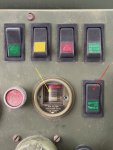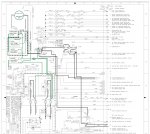We have a rooftop AC unit we like and use regularly: Nomadic X3 24v. It has been a journey and you can read about it
here on Steelsoldiers, including an updated schematic of our current electrical system.
Where we are today:
1— replaced the undersized 12v/24v 100a alternator with a 24v 200a unit. We used a J-180 type, though there are pad mounts others have found we would likely use in the future;
2— replaced the 12v electrical supply with 2 - Victron Orion 24v/12v 70a DC to DC converters: one for truck systems, one for added accessories;
3— we are back to four batteries together, 2 banks in parallel, 2 - 12v 100ah in series (24v 200ah) feeding two separate distribution systems each headed by the Victron Orion 24v/12v 70a DC DC converters. This system works very well. In our current configuration the rooftop AC provides a sustained outlet temperature of 61F in Max mode using 53a. In Eco mode we have observed a sustained outlet temperature of 48F pulling 34a. Note: Eco mode moves less CFM, lowering the BTU's delivered. We have seen as high as 28F sustained differential, between inlet and outlet temperatures. These observed outlet temperatures are consistent with Nomadic's specification sheet for this unit. We have yet to use the unit as currently configured over 94F outside temperature;
4— With the rooftop unit the limiting factor is the volume (cfm) of air moved. If we are running errands leaving the AC running during stops is required to keep the cab comfortable as it takes some time to cool a hot cab. Once cooled down, it maintains temperature well. We have used the factory dash fan to move more air about the cab and this creates more 'cooling breeze' effect, though the noise is quite loud and certainly does not increase true cooling to the cab. Better insulation on the fan box and venting may make it quieter.
The rooftop unit is quiet, efficient and for our use suitable. The 24v 200a alternator easily maintains the four battery system and both electrical systems. Our maximum observed draw from the alternator has been 68a and lowest voltage 25.5v while charging. We did reprogram the low voltage cutoff on the AC unit raising it to 24v to save enough for truck systems at all times, if we leave the AC on while the engine is off. We have run the AC without the engine on and the low voltage cutoff does work allowing the truck to start without recharging the system. We will have a way to charge the truck AGM's off the habitat's lithium system in the future.
If you are looking to create an cab ICEBOX the factory (A1R and later) RedDot Gen2 units put out about
2.5 times as many BTU's as the rooftop Nomadic X3 24v. The Nomadic units are designed for small habitats (sprinter van size) with a lithium 400ah battery pack to run overnight maintaining 78F. Cooling a fish bowl like truck cab to 72F is not what these units were made to do. The newer Nomadic rooftop versions looks more promising, though I doubt any rooftop unit will cool as well as a factory engine driven unit. I hear Ronmar is designing a custom AC unit for his A0 truck and I think that may be very interesting. I also think a separate electrical compressor, condensor coupled to an evaporator in the factory box would deliver more cooling than a rooftop unit.
Would I do a rooftop again. Likely, though I can see advantages to the Red Dot Gen 2 system if you can find one or cobbling together a custom engine or electrical unit. I am concerned either of these dash units would be loud like the A0 and A1 heater boxes. We like the quiet of the rooftop unit and they are half the cost of the Red Dot's we have seen—




